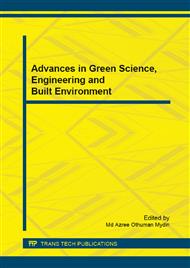[1]
M.A. Othuman Mydin, N. Md Sani, M. Taib, Industrialised Building System in Malaysia: A Review, Building Surveying and Technology MATEC Web of Conferences , 10 (2014) 01002.
DOI: 10.1051/matecconf/20141001002
Google Scholar
[2]
M.A. Othuman Mydin, Thin-walled steel enclosed lightweight foamcrete: A novel approach to fabricate sandwich composite. Australian J. of Basic & Applied Sciences, 5 (2011): 1727-1733.
Google Scholar
[3]
M.A. Othuman Mydin, N. Md Sani, A.F. Phius, Investigation of Industrialised Building System Performance in Comparison to Conventional Construction Method, MATEC Web of Conferences , 10 (2014) 04001.
DOI: 10.1051/matecconf/20141004001
Google Scholar
[4]
M.A. Othuman Mydin, Y.C. Wang, Structural Performance of Lightweight Steel-Foamed Concrete-Steel Composite Walling System under Compression. Journal of Thin-walled Structures, 49 (2011): 66-76.
DOI: 10.1016/j.tws.2010.08.007
Google Scholar
[5]
C.H. Mao, M.A. Othuman Mydin, X.B. Que, Analytical model to establish the thermal conductivity of porous structure, Jurnal Teknologi, 69 (2014) : 103-111.
DOI: 10.11113/jt.v69.2508
Google Scholar
[6]
M.A. Othuman Mydin, N. Noordin, Z. Matori, N. Md Sani, N.F. Zahari, Experimental Investigation into Pull-Out Strength of Foamed Concrete Using Different Types of Screw, Building Surveying, MATEC Web of Conferences, 15 (2014) 01021.
DOI: 10.1051/matecconf/20141501031
Google Scholar
[7]
H.G. Kessler, Cellular lightweight concrete, Concr. Engineering International, 1998, pp.56-60.
Google Scholar
[8]
M.A.O. Mydin, A.F. Phius, N. Md Sani, N.M. Tawil, Potential of Green Construction in Malaysia: Industrialised Building System (IBS) vs Traditional Construction Method, E3S Web of Conferences, 3 (2014) 01009.
DOI: 10.1051/e3sconf/20140301009
Google Scholar
[9]
Shankar Ganesan, Md Azree Othuman Mydin, Norazmawati Md. Sani, Adi Irfan Che Ani, Performance of Polymer Modified Mortar with Different Dosage of Polymeric Modifier, MATEC Web of Conferences, 15 (2014) 01019.
DOI: 10.1051/matecconf/20141501039
Google Scholar
[10]
M.A. Othuman Mydin, M.F. Mohamed Shajahan, S. Ganesan, N. Md. Sani, Laboratory Investigation on Compressive Strength and Micro-structural Features of Foamed Concrete with Addition of Wood Ash and Silica Fume as a Cement Replacement, MATEC Web of Conferences, 16 (2014).
DOI: 10.1051/matecconf/20141701004
Google Scholar


